With an annual Enterprise license or the EDU Institution license, you are able to use single sign-on (SSO) authentication in order to control access to your Slido organization and to your individual slidos.
In this article:
There are two types of SSO protection that you can set up in Slido:
- Participant SSO manages the participants' access. Use Google SSO or SAML based SSO authentication to make sure that only people from your company or specific department can join your internal meetings via Slido.
- Member SSO manages the host access which allows the members to create and manage slidos. Only SAML SSO is supported.
Both SSO types are available only in our Enterprise and Institution plans. Participant SSO is also available in our Premium plan.
Depending on your needs, you can enable both Participant SSO and Member SSO or just one of them. It is also possible to turn off the Participant SSO for a specific slido within its settings. This is useful when you want people outside of your organization to join and participate.
Participant SSO
Slido supports the following authentication methods for your participants:
- Google SSO - If you are using Google Suite at your company, participants can join slidos using their Google login credentials.
- SAML based SSO - You can set up SSO protection for your participants with any IdP that supports SAMLv2.0. This article covers all of the most popular identity providers such as Okta, OneLogin, Microsoft Entra ID (formerly called Microsoft Azure) or Auth0.
- Webex SSO - If your company uses Webex, you can require participants to join using their Webex credentials.
To set up your Participant SSO, open up your Organization settings from your profile menu and select the Privacy tab.
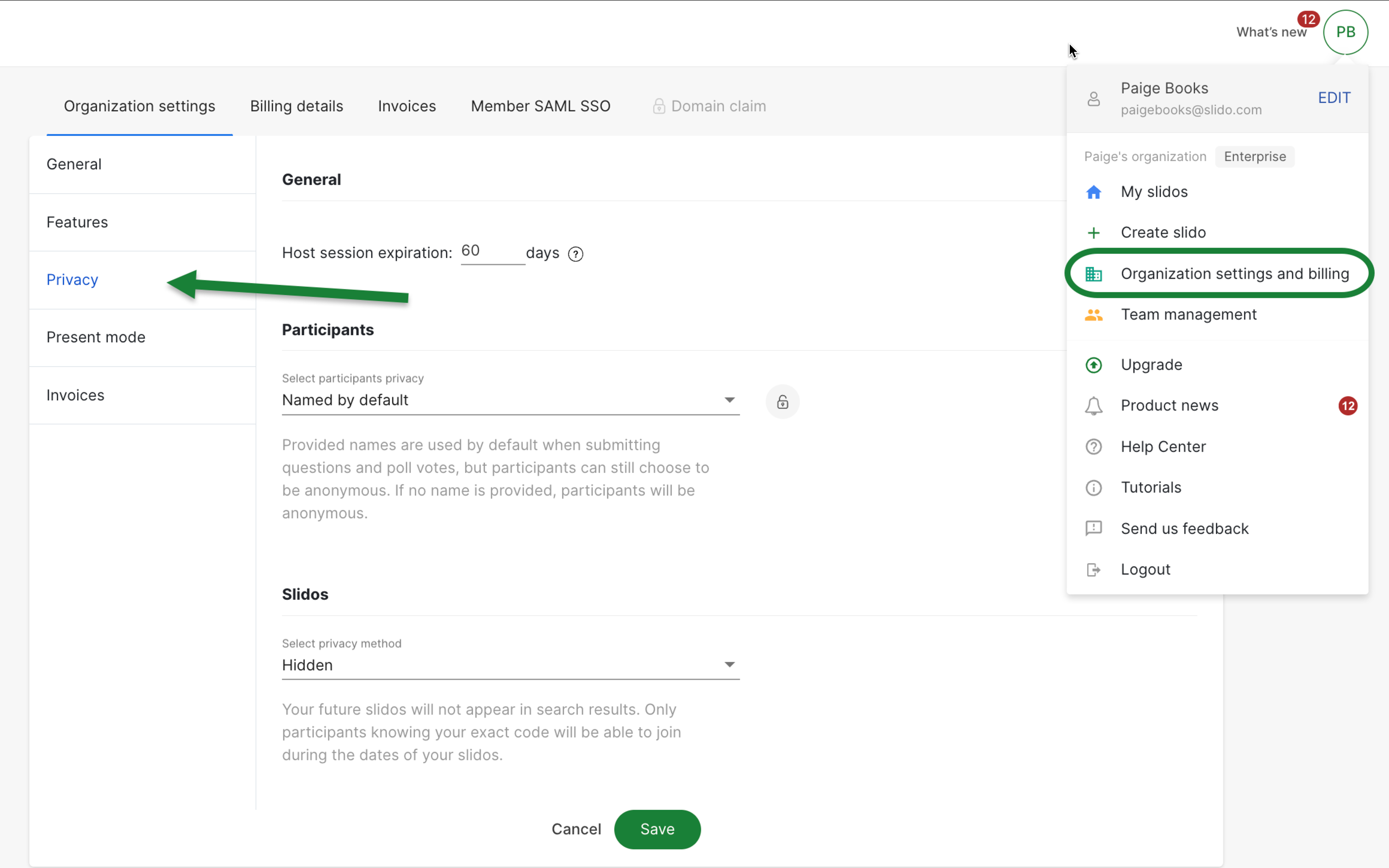
Keep in mind that if you enable Participant SSO for the whole organization, every slido will require participants to join via SSO by default. Members can disable this for individual slidos, unless the account owner locked the setting.
With SSO, your participants can be named or anonymous, depending on the participant privacy setting chosen by the host.
Set up Google SSO or Webex SSO for participants
After opening the Privacy tab of your Organization settings, follow the below steps:
- Change the slido privacy setting to Protected
- From the authentication method drop-down menu, select Google SSO or Webex SSO
- Enter your company domain and select Save
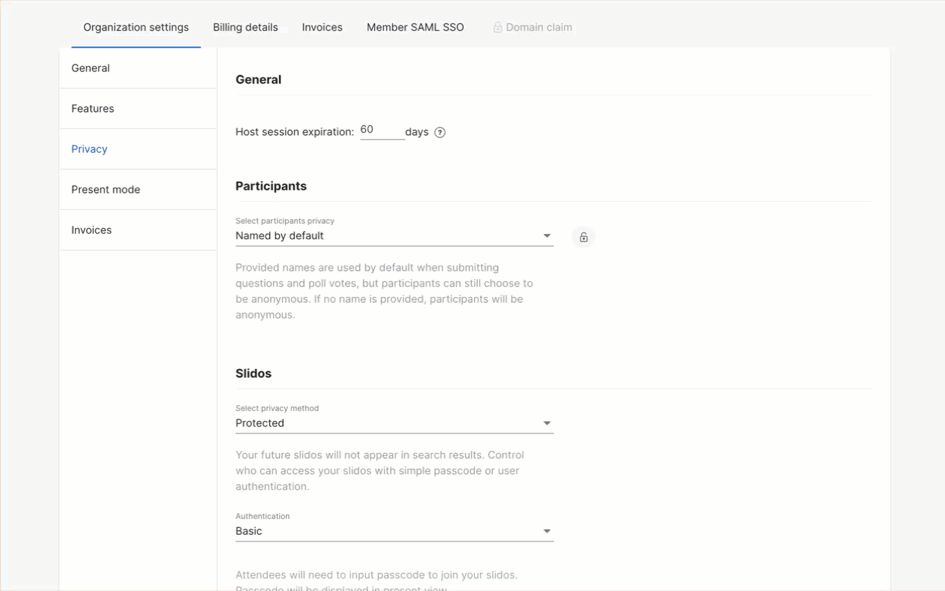
Although the gif above shows Google SSO, the process is the exact same for Webex SSO.
Set up SAML based SSO for participants
After opening the Privacy tab of your Organization settings, follow the below steps:
- Change the privacy method to Protected
- From the authentication method drop-down menu, select SAML based SSO
- Upload your SAML XML file (metadata)
Need help creating your XML file?
Use one of our guides based on what identity provider (IdP) you use: OneLogin, Okta, Microsoft Entra ID (formerly called Microsoft Azure), or Auth0. Send us a message at support@slido.com if you need any help along the way.
Changing the privacy settings
Only Slido admins and account owners can upload the SAML XML file into the organization settings. Once this is set on the organization level, end-users won’t be able to work with SAML XML file anymore, as it will be automatically propagated from the organization settings.
Apply SAML SSO to all existing slidos (optional)
Slido admins and account owners can enforce SAML SSO on all slidos in the organization (including all past and future slidos), improving privacy for your organization.
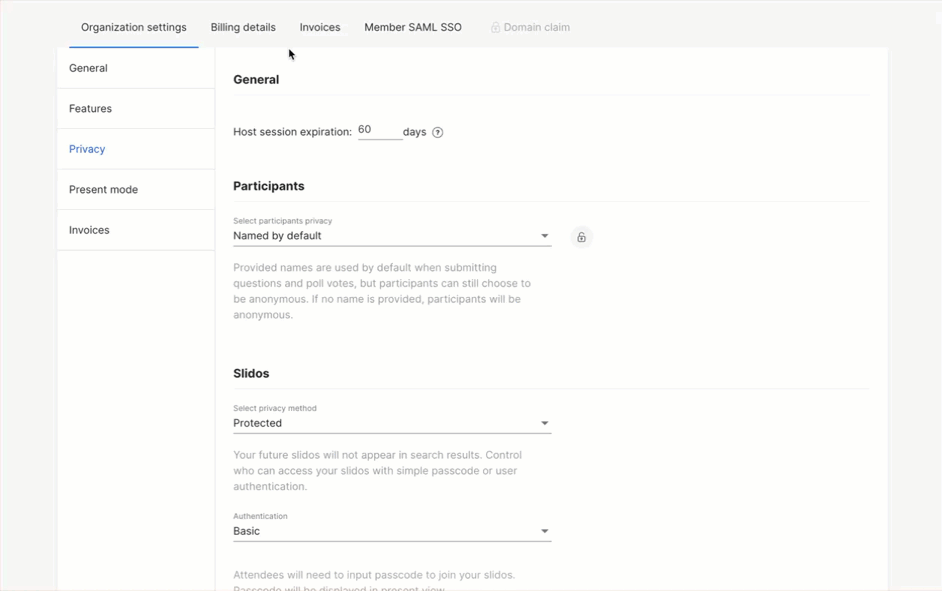
Applying Participant SSO to all slidos still allows hosts to disable this on an individual slido level. If you wish to enforce your Participant SSO for all slidos within your organization, choose the Lock settings option.
SAML SSO configuration details:
Slido authentication process is based on the email as the unique user identifier . Here's the required NameID format:
urn:oasis:names:tc:SAML:1.1:nameid-format:emailAddress
Display name is based on the following SAML attributes in this order:
- cn
- displayName
- name
- firstName, lastName (both must be set), e.g. firstName=John and lastName=Doe then display name=John Doe
- email (user part of email address), e.g. john.doe if the email was john.doe@email.com
This information is included in Slido SAML metadata. You can download it directly from Organization settings - Member SAML SSO tab. At the moment, the Organization or Company is not supported as a SAML attribute.
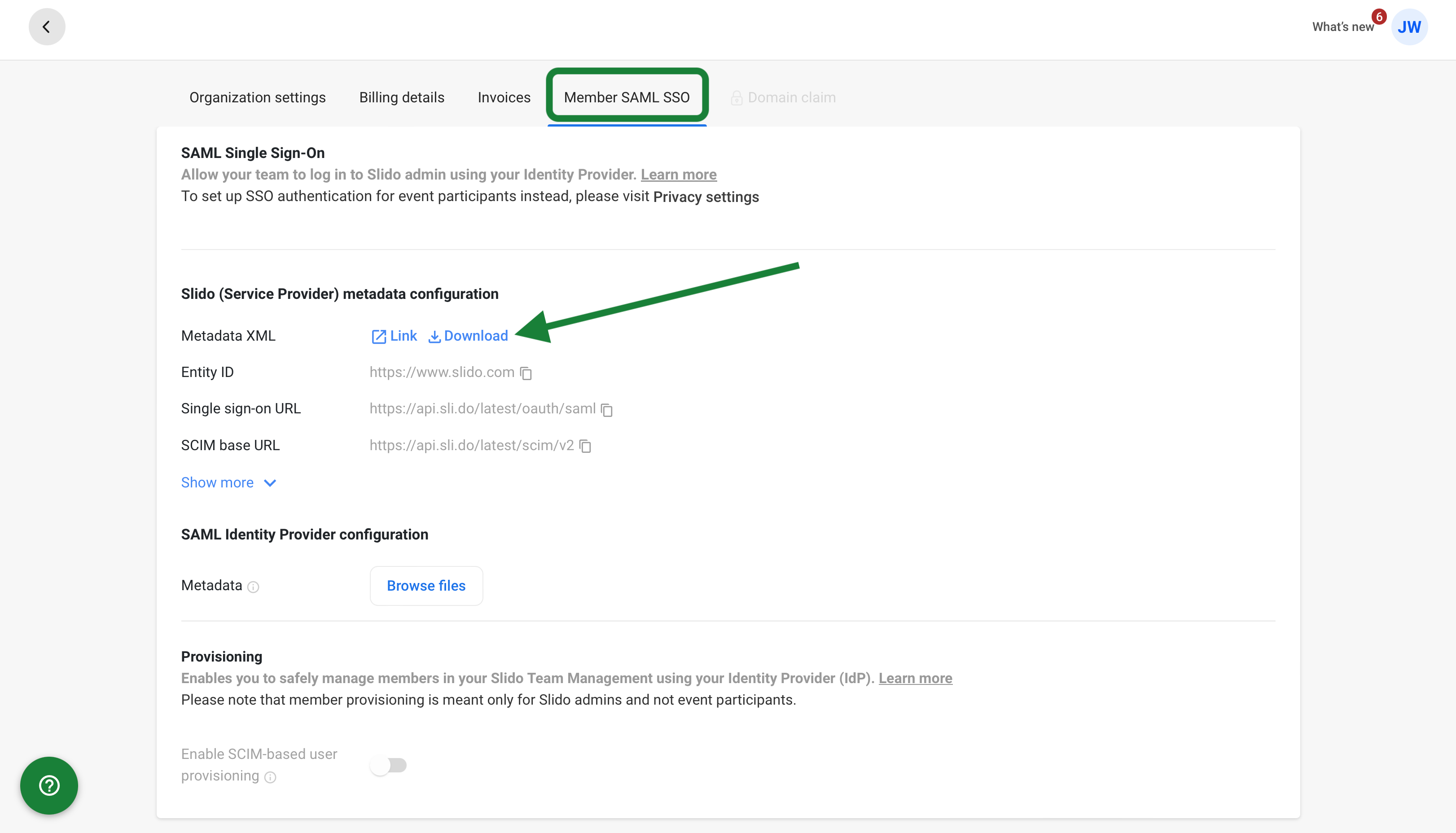
Useful information and FAQ
- Can participants still ask questions anonymously when there is SSO set up for the slido?
Yes! This helps to keep your data Private without any compromise on the level of the audience engagement.
- We usually use Slido for internal meetings, but there will be participants from outside the company at our upcoming event. Will be they able to engage via Slido?
Sure! You can disable the SSO login for a specific slido in its Settings > Privacy > Require authentication > Google/SAML SSO.
Member SSO
SAML-based single sign-on (SSO) gives owners, admins, and members within a Slido organization access to Slido through their Identity Provider (IdP), for example, Okta, OneLogin, Microsoft Entra ID (formerly called Microsoft Azure), or Auth0, and others.
Member provisioning for selected IdPs is also available. It's possible to leverage our implementation of the SCIM protocol in case the IdP adheres to SCIM standards.
Member SSO can only be set up by the owner of the Slido organization.
Steps to set up member SSO:
- Upload your Identity Provider’s SAML metadata XML file to Slido
- Test the configuration
- Enable SSO
- Enforce your members to log in via SSO
- Allow guests to log in without SAML SSO
- Set up Member provisioning in selected Identity Providers
Upload your IdP's SAML metadata XML file to Slido
To get started, you need to set up your Identity Provider and acquire its SAML metadata XML file. Once you have it, you can upload it to your Slido organization.
- Open Organization settings
- Select Member SAML SSO
- Click Browse files to upload your IdP's SAML metadata XML file
Once uploaded, our system validates the XML file.
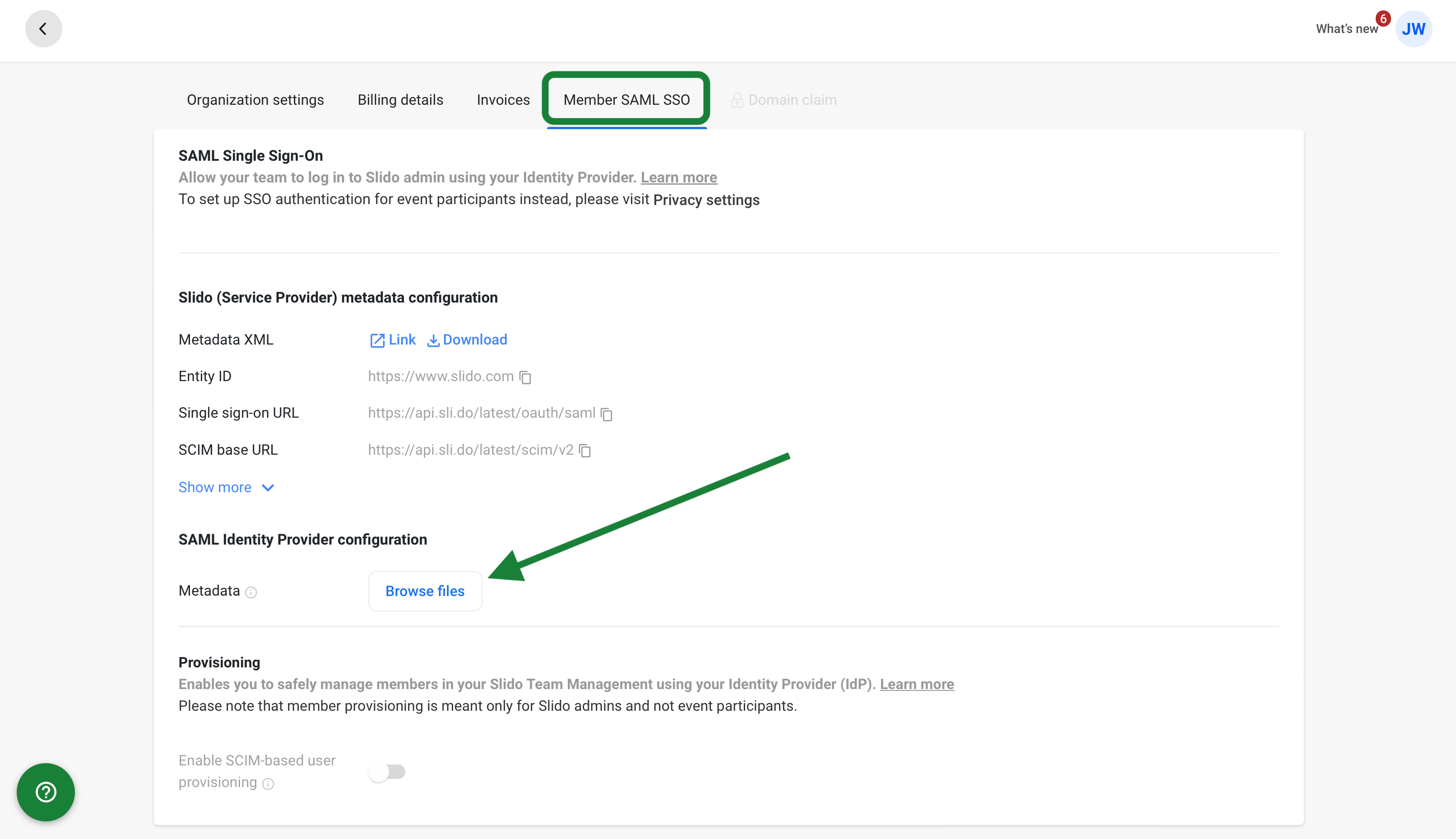
If the file is correct, you will see the Entity ID of your IdP updated. You then may continue with the setup.

Test the configuration
Before enabling the configuration, you first have to test it by clicking Test SAML Login.
This opens a new window redirecting you to your Identity Provider in order to validate that the integration setup is correct on both sides.

Successful test
If the integration is correctly set up and the test is successfully completed you will see a message saying Test successfully completed. Click Got it to go back to your Organization settings to continue with the setup.
Unsuccessful test
If the integration test fails you will see a message saying Test failed. Click Back to to go your Organization settings to fix the issue.
If the test fails, please double-check the uploaded XML metadata file. Also make sure that the person setting up the authentication in Slido is assigned to the associated SAML SSO application on the IdP side.
Enable SSO
After a successful test, you can enable the integration by clicking the Enable SSO button.

How it works for your members:
Once Member SSO is enabled, your members will be able to log in to Slido using SSO.
The member's other login options (such as password or Google login) will still remain available as well. The screenshot below shows the experience of a member who has the option to log in using either password or SAML SSO integration.
Once the member chooses to Log in with SSO, they will automatically be redirected to your Identity Provider.

Enforce your members to log in via SSO
When Member SAML SSO is enabled, you may choose to enforce it by clicking the Enforce SSO button. Enforced SSO means that it is mandatory for members to log in using your Identity Provider. This helps to fully secure your organization account.
How it works for your members:
If the SAML SSO is enforced, any member trying to log in will have to go through your IdP's authentication. The members will no longer have the option to log in with a Slido password or Google SSO. Instead, they will be redirected to your IdP.
Once you enforce SAML SSO, the members who are logged in at that moment will have to re-login to their Slido account.

Allow guests to log in without SAML SSO
By default, when SSO is set up for the organization, members can only invite other existing members to their slidos as guests. Sometimes, it might be useful to invite guests who are not from your company.
To allow inviting guests who are not a part of your Slido organization:
- Open Organization Settings - Member SAML/SSO
- Tick the Exclude guests option
The invited guests who are not part of your organization will use a password or Google account to log in to Slido.

Set up Member provisioning in selected Identity Providers
You can set up SAML SSO and provisioning for your Slido organization in the following IdP's, or any other that complies with SCIM standards:
- Okta
- OneLogin
- Microsoft Entra ID (formerly called Microsoft Azure)
- Auth0
Useful information and FAQs:
- Does Slido SSO authentication work from the service provider side, IdP, or both?
Slido supports both SSO authentication flows.
- How do I renew the SSO certificate?
To renew your SSO certificate in Slido you will first need to disable member SSO in Organization settings. This will log you out so you need to log back in, open Organization settings and select Re-upload which you can find next to Metadata. Now upload your new .xml file, click Test SAML Login and if the test is successful, enable SSO again.
Take a look at our video tutorial for renewing the SSO certificate
- Can we use the same SAML XML file for both - participant and member SSO?
Yes, this is possible. Be careful with using the single file setup with member provisioning though - the participants don't create accounts the same way as Slido organization members. Member provisioning won't work correctly if you mark the participants and the members for provisioning the same way. A 2-app setup on the IdP side is recommended. Please contact us at support@slido.com if you need any help with your member provisioning setup.
- Can I test the member SSO before saving the settings to make sure it's working?
There is no testing environment for the member SSO setup at the moment, but there is a test as a part of the setup process. If the test passes it means the integration is working well and member SSO can be enforced for your Slido organization. That should be sufficient to validate your setup before it's applied to your Slido organization.
Curious about more?

